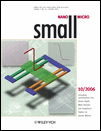Metallothioneins Initiate Semiconducting Nanoparticle Cellular Toxicity†
Baikuntha P. Aryal
Department of Chemistry, Wayne State University, Detroit, MI 48202, USA, Fax: (+1) 313-577-8822
Search for more papers by this authorKosh P. Neupane
Department of Chemistry, Wayne State University, Detroit, MI 48202, USA, Fax: (+1) 313-577-8822
Search for more papers by this authorMarinella G. Sandros Dr.
Department of Chemistry, Wayne State University, Detroit, MI 48202, USA, Fax: (+1) 313-577-8822
Search for more papers by this authorDavid E. Benson Prof.
Department of Chemistry, Wayne State University, Detroit, MI 48202, USA, Fax: (+1) 313-577-8822
Search for more papers by this authorBaikuntha P. Aryal
Department of Chemistry, Wayne State University, Detroit, MI 48202, USA, Fax: (+1) 313-577-8822
Search for more papers by this authorKosh P. Neupane
Department of Chemistry, Wayne State University, Detroit, MI 48202, USA, Fax: (+1) 313-577-8822
Search for more papers by this authorMarinella G. Sandros Dr.
Department of Chemistry, Wayne State University, Detroit, MI 48202, USA, Fax: (+1) 313-577-8822
Search for more papers by this authorDavid E. Benson Prof.
Department of Chemistry, Wayne State University, Detroit, MI 48202, USA, Fax: (+1) 313-577-8822
Search for more papers by this authorThis work was supported by the National Institute of Environmental Health Sciences (ES06639) and the National Science Foundation (DBI-0508134).
Graphical Abstract
The toxicity of CdSe nanoparticles is mediated by metallothioneins (MTs), which are ubiquitous and cysteine-rich. Surface Cd2+ ions are depleted from thiocarboxylate-capped CdSe nanoparticles by recombinant MT-based peptides (see figure), while surface Zn2+ ion depletion from ZnS-coated CdSe nanoparticles is more difficult. Due to the overall cellular expression and antioxidant roles for MT, a model for MT-mediated CdSe nanoparticle toxicity is proposed.
References
- 1A. P. Alivisatos, W. W. Gu, C. Larabell, Annu. Rev. Biomed. Eng. 2005, 7, 55.
- 2X. Gao, L. Yang, J. A. Petros, F. F. Marshall, J. W. Simons, S. Nie, Curr. Opin. Biotechnol. 2005, 16, 63.
- 3I. L. Medintz, H. T. Uyeda, E. R. Goldman, H. Mattoussi, Nat. Mater. 2005, 4, 435.
- 4A. M. Derfus, W. C. W. Chan, S. N. Bhatia, Nano Lett. 2004, 4, 11.
- 5A. Hoshino, K. Fujioka, T. Oku, M. Suga, Y. F. Sasaki, T. Ohta, M. Yasuhara, K. Suzuki, K. Yamamoto, Nano Lett. 2004, 4, 2163.
- 6C. Kirchner, T. Liedl, S. Kudera, T. Pellegrino, A. M. Javier, H. E. Gaub, S. Stolzle, N. Fertig, W. J. Parak, Nano Lett. 2005, 5, 331.
- 7J. Lovrić, S. J. Cho, F. M. Winnik, D. Maysinger, Chem. Biol. 2005, 12, 1227.
- 8V. A. Sinani, D. S. Koktysh, B.-G. Yun, R. L. Matts, T. C. Pappas, M. Motamedi, S. N. Thomas, N. A. Kotov, Nano Lett. 2003, 3, 1177.
- 9B. I. Ipe, M. Lehnig, C. M. Niemeyer, Small 2005, 1, 706.
- 10M. Green, E. Howman, Chem. Commun. 2005, 121.
- 11J. N. Chan, Z. Y. Huang, M. E. Merrifield, M. T. Salgado, M. J. Stillman, Coord. Chem. Rev. 2002, 233, 319.
- 12G. Henkel, B. Krebs, Chem. Rev. 2004, 104, 801.
- 13N. Romero-Isart, M. Vasak, J. Inorg. Biochem. 2002, 88, 388.
- 14E. Aizenman, A. K. Stout, K. A. Harnett, K. E. Dineley, B. McLaughlin, I. J. Reynolds, J. Neurochem. 2000, 75, 1878.
- 15Y. J. Kang, Y. Li, X. Sun, X. Sun, Am. J. Pathol. 2003, 163, 1579.
- 16R. Shimoda, W. Achanzar, W. Qu, T. Nagamine, H. Takagi, M. Mori, M. Waalkes, Toxicol. Sci. 2003, 73, 294.
- 17G. W. Wang, J. B. Klein, Y. J. Kang, J. Pharmacol. Exp. Ther. 2001, 298, 461.
- 18M. G. Sandros, D. Gao, C. Gokdemir, D. E. Benson, Chem. Commun. 2005, 2832.
- 19M. G. Sandros, D. Gao, D. E. Benson, J. Am. Chem. Soc. 2005, 127, 12198.
- 20M. G. Sandros, V. Shete, D. E. Benson, Analyst 2006, 131, 229.
- 21S. A. Empedocles, M. G. Bawendi, Science 1997, 278, 2114.
- 22M. Nirmal, L. Brus, Acc. Chem. Res. 1999, 32, 407.
- 23X. Wu, A. Bittner, K. Kern, J. Phys. Chem. B 2005, 109, 230.
- 24L. Hanus, K. Sooklal, C. Murphy, H. Ploehn, Langmuir 2000, 16, 2621.
- 25A. H. Robbins, D. E. McRee, M. Williamson, S. A. Collett, N. H. Xuong, W. F. Furey, B. C. Wang, C. D. Stout, J. Mol. Biol. 1991, 221, 1269.
- 26C. Capasso, O. Abugo, F. Tanfani, A. Scire, V. Carginale, R. Scudiero, E. Parisi, S. D’Auria, Proteins: Struct. Funct. Genet. 2002, 46, 259.
- 27C. Capasso, V. Carginale, O. Crescenzi, D. Di Maro, E. Parisi, R. Spadaccini, P. A. Temussi, Structure 2003, 11, 435.
- 28J. H. R. Kagi, B. L. Vallee, J. Biol. Chem. 1961, 236, 2435.
- 29S. Jeong, M. Achermann, J. Nanda, S. Ivanov, V. Klimov, J. Hollingsworth, J. Am. Chem. Soc. 2005, 127, 10126.
- 30S. Hohng, T. Ha, J. Am. Chem. Soc. 2004, 126, 1324.
- 31M. Vasak, D. W. Hasler, Curr. Opin. Chem. Biol. 2000, 4, 177.
- 32C. C. You, M. De, V. M. Rotello, Curr. Opin. Chem. Biol. 2005, 9, 639.
- 33M. L. Flenniken, D. A. Willits, S. Brumfield, M. J. Young, T. Douglas, Nano Lett. 2003, 3, 1573.
- 34Z. A. Peng, X. Peng, J. Am. Chem. Soc. 2001, 123, 183.
- 35P. W. Riddles, R. L. Blakeley, B. Zerner, Anal. Biochem. 1979, 94, 75.





